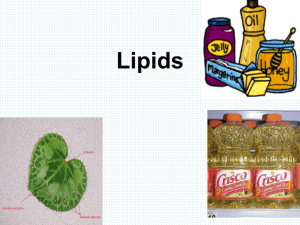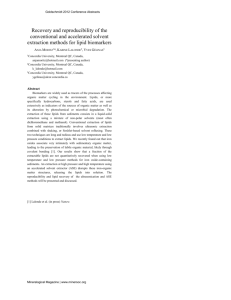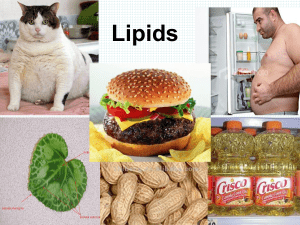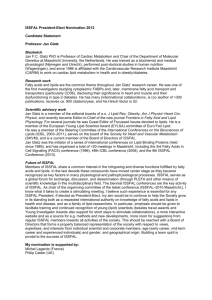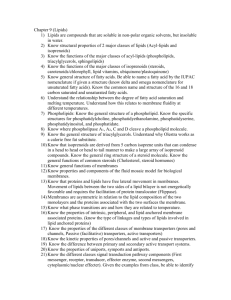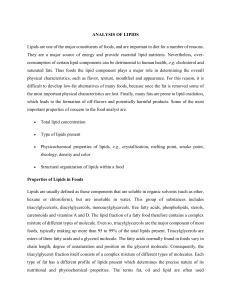Food Composition Analysis
advertisement
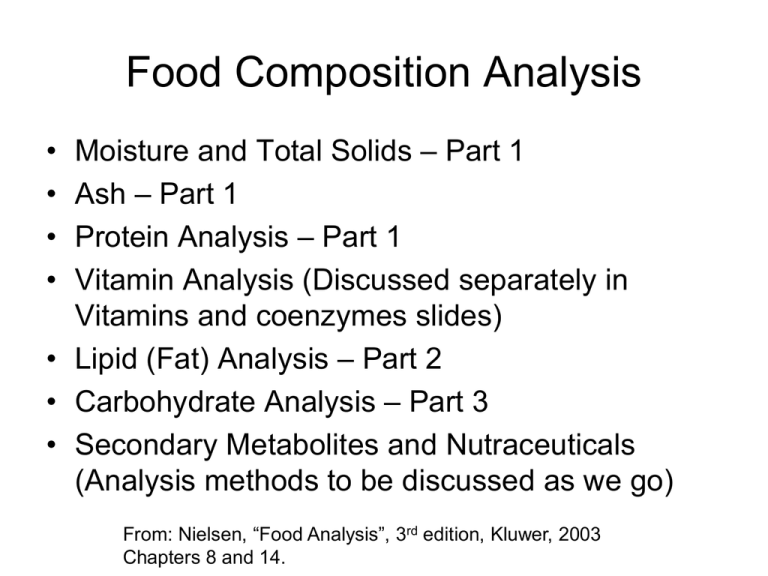
Food Composition Analysis • • • • Moisture and Total Solids – Part 1 Ash – Part 1 Protein Analysis – Part 1 Vitamin Analysis (Discussed separately in Vitamins and coenzymes slides) • Lipid (Fat) Analysis – Part 2 • Carbohydrate Analysis – Part 3 • Secondary Metabolites and Nutraceuticals (Analysis methods to be discussed as we go) From: Nielsen, “Food Analysis”, 3rd edition, Kluwer, 2003 Chapters 8 and 14. Lipids • Mainly present in foods as triacylglycerols (fats and oils), other fatty acid esters, phospholipids (e.g. lecithin), sterols and other isoprenoids, fatsoluble vitamins (A, D, E, K) • Lipid composition varies greatly between animal and plant-based foods and within plant-based foods (table 8-2) • Most lipids are soluble in nonpolar solvents (e.g. ether, chloroform) but some also have limited water-solubility From: Nielsen, “Food Analysis”, 3rd edition, Kluwer, 2003 Chapters 8 and 14. Lipids – quantitative analysis • Accurate lipid analysis requires effective extraction from the food matrix • extraction methods tailored to particular food • nonpolar solvents utilized – hexane, ethyl ether, petroleum ether • extract, dry and weigh • hydrolysis may be needed with complex lipids to release lipid from carbohydrate/protein moieties • steps may be taken to minimize oxidation – addition of BHT or other antioxidant Extraction of lipids • Most effective if samples pre-dried • Samples are ground to reduce particle size, maximize surface area • Blending helps saturate particles • Hydrolysis (1 hr reflux w 3 M HCl or saponification with ethanolic KOH) needed with dairy, grains, animal products • Sequential solvent extractions of plant materials begin with least polar solvent and increase in polarity so that lipids are removed first, other constituents follow • Reverse-phase separation methods isolate the polar constituents first, lipids last Lipid extraction methods • Continuous solvent extraction – sample exposed to boiling solvent for several hrs • Semicontinuous (Soxhlet extraction) – same idea but periodic solvent exposure • Mojonnier flask or Babcock methods (dairy) use a digestion step prior to allowing fat to separate • Microwave-assisted extraction often used w dairy, meats • Ultrasound-assisted extraction • Supercritical fluid extraction – “green” method uses pressurized CO2 – hybrid gas-liquid state at 80oC, 10,000 psi – fluid pumped through sample cell, collected at ambient pressure, 60oC and rotary evaporated Diagram of SFE From Brazilian J. of Chem. Eng. at http://www.scielo.br/scielo.php? Instrumental lipid quantification • NMR – low resolution is effective because one monitors broader regions – CW NMR can determine degree of unsaturation – pulsed NMR – oil vs. solid fat content can be determined - protons relax faster in solids – signal amplitude is proportional to quantity • IR - fat absorbs strongly at C=O stretching region (1745 cm-1) – meat, dairy, oilseeds • x-ray absorption – higher in lean meat than fat • ultrasound – fat content in meats Lipid characterization Ch. 14 (Nielsen) • Iodine value – degree of unsaturation • Saponification equivalents • Free fatty acids Lipid oxidation status & oxidation products • TBARS test for malondialdehyde • conjugated dienes & trienes by UV • volatile organics by GC • fatty acid composition by GC (14.6.2) • trans fatty acids by IR (14.6.3) – total trans fatty acids quantified based on trans C=C absorption at 967 cm-1 Chemistry of TBARS test Colored adduct is measured at 530 nm GC analysis for FA composition • Fatty acids can be derivatized to their volatile methyl esters (FAME) • acid/MeOH or NaOMe can be used • short chain FA are volatile, some water solubility; can prepare iPr esters instead • derivatization as DMOX (4,4-dimethyloxazolines) often used • GC-MS employed if standards are inadequate • Capillary GC on moderately polar PEG or carbowax, medium length column (25 m x 0.25 mm) separates most FAME • Longer (100 m) cyanopropyl columns needed to separate trans-FA from cis-isomers • complex mixtures of FAME including w-3/w-6 fatty acids can be separated by cap-GC in < 30 min (Fig. 2.3). From Methods of Analysis for Functional Foods and Nutraceuticals, Chapter 2” Cap GC analysis of fish/sunflower oil mixture Conjugated linoleic acid (CLA) • Discussed in detail in Hurst, Ch. 2 • Analysis poses a challenge because of the mixture of isomers • Cap GC on 100 m cyanopropyl column requires long runtime (80 min) • Silver-ion HPLC: Ag+ forms polar pi-bonded complexes with unsat. FA – Si column packings impregnated with silver developed for lipid analysis (normal-phase LC) – http://lipidlibrary.aocs.org/topics/silver/index.htm
